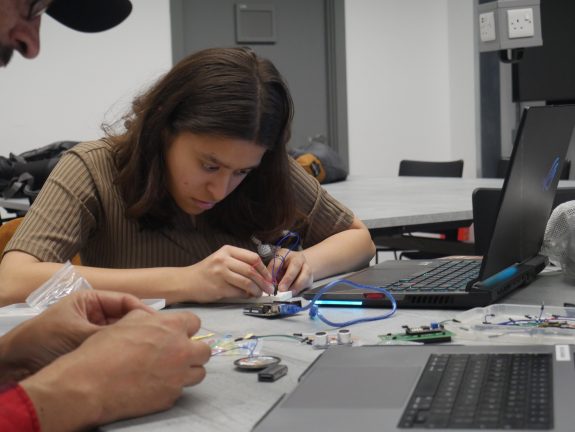By Drake Music Associate Musicians, David McFarlane and Billy Payne.

What better way to mark the end of our first academic year partnership with SODA (School of Digital Arts) at Manchester Metropolitan University, than with a mini-hackathon?
Back in March, we invited DMLab North-West participants old and new to create a prototype or concept aimed at tackling an access barrier in music-making. The brief was intentionally broad, but the big challenge was time — being a mini-hackathon, the teams had just three hours to develop a concept and present it back to the group.
Alongside familiar DMLab faces from our regular sessions, we were delighted to be joined by students from SODA. We provided a range of materials to kickstart ideas, including Arduinos and sensors, Arduino-compatible devices like the Neotrellis button pad boards and the programmable Lilygo T-Watch, a selection of games controllers, and other bits and pieces. Some of the standout projects included:
Melody Recorder using Neotrellis:
A team of computer science students from MMU developed a device based on the Neotrellis programmable grid controller. Their project allowed users to record short melodies and play them back at different speeds, creating interesting performance possibilities.

Accessible Drum and Sample Triggers:
DMLab North-West veteran Sam led a group in prototyping a collection of accessible drum/sample triggers. They began by using widely available dog training buttons (which can record and play short sounds) and then moved toward a more MIDI-friendly capacitive touch system using Arduino.

Clay Wind Instrument Performance:
One of the most striking performances of the evening featured a wind instrument built around a clarinet mouthpiece, mounted inside a hand-crafted clay body. A piezo sensor captured the sound, which was pitch-shifted in Ableton Live to generate lush, expressive chords.

Xbox Adaptive Controller Experiments:
Another group explored the Xbox Adaptive Controller in combination with TouchOSC, mapping controller functions to MIDI notes and expression. They also demonstrated how the adaptive controller can be expanded by connecting other switches and devices — either to create custom instruments for a single player, or to allow multiple people to share control of notes and expression collaboratively.
TouchOSC Musical Interfaces:
A group of UI/UX students experimented using TouchOSC to design and prototype musical control surfaces, exploring how accessible musical interfaces could be built around mobile devices.
New App Preview – Emotion and Harmony:
We also got an exciting preview of a new app that explores chords and harmony through an interface based on human emotions and facial expressions, offering a fresh approach to musical creativity.
Summary
Despite the tight timeframe, the creativity and energy in the room was fantastic. It was inspiring to see so many different approaches to accessible music making, and how quickly participants turned ideas into working concepts! We’re thankful for the support and facilities offered by SODA, and are excited to continue working with the University over the course of the next academic year!



